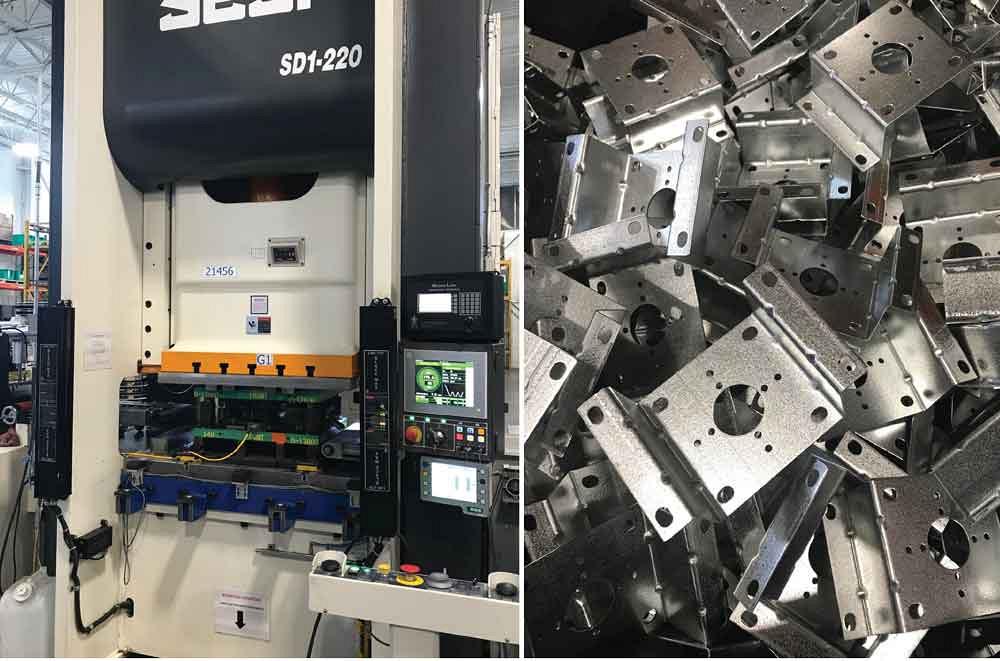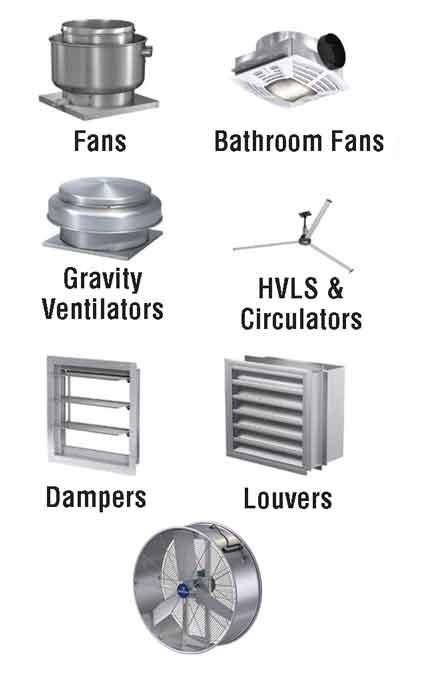Contributing editor
- FMA
- The Fabricator
- FABTECH
- Canadian Metalworking
Categories
- Additive Manufacturing
- Aluminum Welding
- Arc Welding
- Assembly and Joining
- Automation and Robotics
- Bending and Forming
- Consumables
- Cutting and Weld Prep
- Electric Vehicles
- En Español
- Finishing
- Hydroforming
- Laser Cutting
- Laser Welding
- Machining
- Manufacturing Software
- Materials Handling
- Metals/Materials
- Oxyfuel Cutting
- Plasma Cutting
- Power Tools
- Punching and Other Holemaking
- Roll Forming
- Safety
- Sawing
- Shearing
- Shop Management
- Testing and Measuring
- Tube and Pipe Fabrication
- Tube and Pipe Production
- Waterjet Cutting
Industry Directory
Webcasts
Podcasts
FAB 40
Advertise
Subscribe
Account Login
Search
Air movement equipment manufacturer advances with servo press system, Part I
New press boosts fan manufacturer’s innovation and expands its stamping capacity
- By Kate Bachman
- May 28, 2020
- Article
- Bending and Forming

Air movement equipment manufacturer Greenheck needed to expand its stamping capacity, accelerate production, and counter forming problems like springback. It installed a SEYI servo press system. Images provided
Editor’s Note: This article is Part I of a two-part article. To learn more about the press, read Part II.
Greenheck is one of the world’s largest manufacturers of air movement, control, and condition equipment for commercial, institutional, and industrial companies.
The Schofield, Wis., manufacturer has developed a global presence by innovating an array of equipment to move and condition air—and then moving heaven and earth to meet delivery, installation, and performance expectations.
With 3,500 employees worldwide, the company has expanded via product innovation. Greenheck’s comprehensive line of ventilation equipment includes fans, dampers, louvers, kitchen ventilation hoods, energy recovery, makeup air units, indoor air handling units, dedicated outdoor air systems, energy recovery ventilators, duct heaters, HVAC coils, airflow measurement, motor starters, fan monitoring systems, and centrifugal and vane axial fans. Its smallest fan is 12 by 12 by 4 in., commonly used in hotel restrooms; its largest is a lab exhaust fan at 12 ft. tall by 10 ft. by 6 ft.
Ironically, considering the omnipresence of its products, they are rarely visible. “Most of our work is hidden in ceilings and duct works,” said Manufacturing Engineer Tom Franke.
Like its products, much of Greenheck’s innovation is unseen because it occurs in its operations. One of its recent operational innovations was installing a new servo press system.
Capacity Expansion Needed to Meet Product Demand
The manufacturer needed to bump up its stamping capacity rapidly to meet growing product demand.
Growing Pains. “Because of the growth that we’ve seen here at Greenheck, we’ve needed to expand pretty rapidly,” Franke said, who manages the stamping and tool and die operations at the company’s Schofield, Wis., plant. A number of buildings were added throughout the U.S. to add capacity, opening the opportunity to move the stamping department into its own building and to upgrade its stamping operations.
Some of the company’s presses were aging. One 125-ton mechanical press, in particular, was ready for a rebuild.
“We figured if we’re moving it over, we might as well rebuild it or replace it,” Franke said. He evaluated whether it was worth upgrading the press or if he should replace it. Franke and his team got a quote on the cost to rebuild the old press and move it.
“It was at a point where we could spend $100,000 on this old press, and yeah, it would last us, but it still would not give us the innovation and other features of a new press,” he said. He decided to purchase a new press.
Stubborn Springback Requires Special Attention
Franke said he was looking for a new press that would ease some current challenges. In the making of blades for fan propellers, one of the biggest stamping problems is with springback. “We need to hold a rigid curved profile so that our fans perform well. It’s pretty imperative that we can stamp parts to meet tolerance.”
Materials. The blades are stamped from a range of materials—5052 aluminum, 3000 aluminum, hot-rolled steel, cold-rolled and galvanized steel, and stainless steel.
All of them have some kind of springback tension in them, Franke said. “You always have to deal with that with those materials.“
Two Operations to One. In the past, how the company combated springback was to blank out the parts on a mechanical press and then hand-feed them to a hydraulic press, using the programmable action to lower the ram slowly to stress-relieve that material tension to form those parts. “Obviously, using two operations to make a part is not as cost-effective as using one,” Franke said.
Downstream Operations. Meeting tolerances is not only a function of fan performance, but is even more critical for downstream operations, such as welding. Typically, the blades are robotically welded, so if they don’t stay within tolerances, they need extra work at every run.
“But when our parts are in tolerance, they don’t need to be touched and we don’t have any weld or quality issues on them.”
Servo Press Helps Resolve Problems
Franke said the company’s integrators and salespeople alerted him to the advantages of a servo press. He and his team did some benchmarking, visited different facilities that had servo presses, and talked with operators and production management there to see what they experienced with them.
“We saw the value of a servo press and the innovation it could bring to our business,” Franke said.
One of the first actions they took was to try to match existing tooling with the press, based on volumes. They determined that they could put additional volume on a new servo press. They also evaluated the bed size.

The new servo press helped increase productivity and throughput by more than 15% right away because the operators could take advantage of servo modes like pendulum.
“Once we spec’d the press, we reached out to our machine vendors, acquiring quotes, and trying to get an apples-to-apples comparison so we could make a good judgment.”
Greenheck replaced the older 125-ton mechanical press in February 2019 with a new SEYI SD1-220 servo press system with fully automated material handling.
The SD1 220 servo press was selected primarily based on tooling dimensions, die tonnage, and maximum stroke length requirements, according to Rick Wenzel of BDC Machinery, the integrator that coordinated the press system installation. The flexibility of the programmable servo press allowed Greenheck to optimize stroke length and press speed for each die scheduled to run through this cell.
“SEYI’s standard control functions allowed quick setup of press perimeters. Also, the controller was adaptable so that the communication with auxiliary equipment required could occur,” he explained.
Using Servo Features to Battle Springback, Advance Pace
Franke said that he and his team are already using some of the profiles that are unique to the servo press. Two of the modes help them counter springback problems, and the other helps speed up throughput.
Hold at BDC. One profile they’re using is the ability to hold at bottom dead center. “That way we can stress-relieve the part before the ram comes back up. We’re holding tighter forms and tighter draws on some of these AHSS parts,” Franke said.
Pulse Mode. Another profile that Franke said they are just delving into is the vibration, or pulse, mode. “We’re coming down and making multiple hits to counter springback. That way, we can reduce the number of stations that the die requires. So we’re reducing our die costs essentially. It’s a unique capability—something that we couldn’t do with a mechanical press.
“Now we just run off a coil, using the servo press’s unique profiles to stress-relieve the parts and a smaller die with fewer stations.”
Pendulum Motion. One of the first profiles they used is the pendulum motion, which helps accelerate throughput. “We can make that stroke shorter. Our mechanical presses run in that standard stroke length so we can’t get any more speed out of the machine beyond what it’s actually rated for. That’s been a really nice feature,” Franke said.
Meeting Increased Demand
Franke said the new press has helped the company meet the uptick in demand for more product production.
“We’ve seen about a 15% productivity increase on the dies that run on the servo versus the old press,” he said. “Now we’re actually starting to work with design engineers throughout the company to take greater advantage of the servo press, bring more parts into stamping, and actually increase the work load on that machine.
“We definitely opened up some capacity there.”
Morale Boost
Franke said that the new press has brought an unexpected benefit as well. The operator morale has increased with the new technology. “It’s something
different. The majority of our operators have been incredibly excited. They’ve wanted to dive into the machine to see what they can do with it; ‘How can I make it run faster?’”
Press Installation Includes Automated Material Handling
The press system’s performance goes beyond the press’s features and capabilities. It was designed with a focus on quick changeover—not only of the die but the entire coil feed and material handling—so that Greenheck could produce small part batches and implement lean manufacturing.
About the Author

Kate Bachman
815-381-1302
Kate Bachman is a contributing editor for The FABRICATOR editor. Bachman has more than 20 years of experience as a writer and editor in the manufacturing and other industries.
subscribe now

The Fabricator is North America's leading magazine for the metal forming and fabricating industry. The magazine delivers the news, technical articles, and case histories that enable fabricators to do their jobs more efficiently. The Fabricator has served the industry since 1970.
start your free subscription- Stay connected from anywhere

Easily access valuable industry resources now with full access to the digital edition of The Fabricator.

Easily access valuable industry resources now with full access to the digital edition of The Welder.

Easily access valuable industry resources now with full access to the digital edition of The Tube and Pipe Journal.
- Podcasting
- Podcast:
- The Fabricator Podcast
- Published:
- 04/30/2024
- Running Time:
- 53:00
Seth Feldman of Iowa-based Wertzbaugher Services joins The Fabricator Podcast to offer his take as a Gen Zer...
- Industry Events
Pipe and Tube Conference
- May 21 - 22, 2024
- Omaha, NE
World-Class Roll Forming Workshop
- June 5 - 6, 2024
- Louisville, KY
Advanced Laser Application Workshop
- June 25 - 27, 2024
- Novi, MI
Precision Press Brake Certificate Course
- July 31 - August 1, 2024
- Elgin,
































